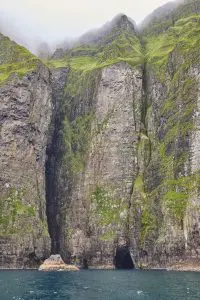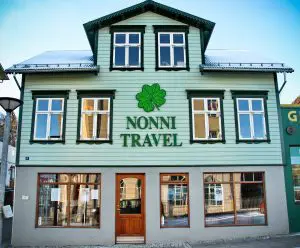Cave Tours in the Faroe Islands
Cave Tours in the Faroe Islands
Learn More About Cave Tours in the Faroe Islands
 If you think the North Atlantic has already revealed all its secrets, the Faroe Islands will happily prove you wrong. These emerald-rimmed isles conceal a labyrinth of grottoes that can only be reached by small boat or on foot with a local guide, transforming a simple excursion into a genuine expedition.
If you think the North Atlantic has already revealed all its secrets, the Faroe Islands will happily prove you wrong. These emerald-rimmed isles conceal a labyrinth of grottoes that can only be reached by small boat or on foot with a local guide, transforming a simple excursion into a genuine expedition.
Most travelers start with a boat ride from Vestmanna or Gamlarætt to Klæmintsgjógv, reputed to be the world’s largest sea cave by volume. Inside, the ceiling curves like the nave of a cathedral, and when ocean swells roll in, the acoustics are so pure that summer “grotto concerts” are held here. Guides cut the engine, hand out blankets, and let Faroese folk songs echo off the basalt walls, an experience that gives goosebumps.
For a quieter adventure, steer toward Hestur’s lesser-known caverns. The island’s name means “horse,” and its cliff-side caves resemble dark stables chiseled by the surf. Seabirds wheel overhead, and the water glows a surreal turquoise against the inky rock. Pack a waterproof jacket, as Atlantic spray is part of the fun, and your photos will thank you.
Land-based cave tours offer a different thrill. Hiking guides lead small groups to hidden lava cavities above Miðvágur, where trolls were once said to store their treasure. Bring sturdy shoes. The paths are steep but rewarding, opening onto moss-covered sinkholes and crystal-clear underground pools.
Whether you crave the booming resonance of a sea cavern or the hush of a landlocked lava chamber, cave tours in the Faroe Islands deliver raw Nordic drama in manageable, family-friendly doses. Add a trip to these grottoes to your itinerary, and you’ll return with stories as deep as the caves.
Our Atlantic Neighbors: Travel Stories, Folklore & Hidden Gems in the Faroe Islands
Discover the Faroe Islands by Car: A Local’s Guide to Self-Drive Tours
Velkomin!
How We Will Create Your Lifetime Journey: Best Self-Drive Tours in Iceland and the Faroe Islands
Why Coolcations Are the Future of Travel: Iceland, the Faroe Islands, and Greenland Should Top Your List!
Most Common Questions About Cave Tours in the Faroe Islands
What makes cave tours in the Faroe Islands different from other Nordic destinations?
Unlike Iceland’s lava tubes or Norway’s fjord grottos, Faroe Islands cave tours take you into basalt chambers that open straight onto the Atlantic. The mix of towering sea cliffs, echo-rich caverns, and bird-filled skies creates a rugged setting you won’t find anywhere else in the North Atlantic.
What’s the difference between a boat cave tour and a hiking cave tour?
Boat tours access sea-level chambers carved by waves, while hiking excursions explore inland lava cavities and sinkholes. Both showcase the islands’ volcanic past but deliver contrasting viewpoints.
Can I visit the Faroe Islands caves on my own without a guide?
Some shore caves near Sandavágur are accessible at low tide, yet shifting swells and limited exit points make professional guidance the safer, strongly recommended choice.
Any photography tips for capturing the Faroe Islands sea caves?
Set your ISO higher than usual to compensate for dim interiors, and shoot bursts when the skipper cuts the motor, still, boats mean sharper images. A lens cloth is invaluable. Atlantic mist settles on the glass fast.
Where do the cave tours in the Faroe Islands depart from?
Will I get a seasick?
Sea conditions can be choppy, especially outside the fjords. If you’re prone to motion sickness, consider taking medication beforehand.
How long does a typical cave tour last?
Boat-based routes run 90–120 minutes, including time spent drifting inside each cavern. Hiking cave tours above Miðvágur or on Sandoy can last up to three hours, with frequent photo stops.
When is the best time of year to book a Faroe Islands cave tour?
Late May through early September offers long daylight hours, relatively calm swells, and the highest number of scheduled boat departures. June and July see peak demand, so reserve seats early if you want prime slots for popular sea caves, such as Klæmintsgjógv.
How do I arrange a boat cave tour from Tórshavn or Vestmanna?
Most licensed skippers list timetables online. You can also check our day tours and make direct bookings. If you’re already in Tórshavn, local tourist offices can place you on the next available sailing with vetted operators.
Which sea caves are considered must-see highlights?
Klæmintsgjógv on Hestur is the marquee attraction for its cathedral-like vault. Smaller but equally photogenic spots include the turquoise chambers under Leynar and the bird-nesting grottoes near Vestmanna sea cliffs.
Are Faroe Islands cave tours suitable for families with young children?
Yes, many skippers accept kids aged five and up, fitting them with child-size life jackets and keeping tour lengths under two hours. Always confirm age limits and sea-state forecasts before you set off.
Are grotto concerts still held in Klæmintsgjógv cave?
Yes, select evenings in July feature acoustic shows inside the vast chamber. Tickets pair the concert with a sunset boat transfer. Check our tour offer for direct information about availability.
Can I combine a cave tour with bird-watching?
Absolutely. Summer cave routes skirt puffin colonies and fulmar nests along the Vestmanna cliffs, so bring binoculars for a two-for-one wildlife and geology experience.
Are cave tours safe in Faroese weather?
Licensed captains monitor swell height and wind direction hourly. Tours are postponed or rerouted when seas exceed safety limits, ensuring visitors experience the caves only in stable conditions.
What gear should I pack for a Faroe Islands cave excursion?
Layers are essential: a wind-blocking shell, quick-dry trousers, and waterproof shoes. A compact dry bag protects cameras and phones from Atlantic spray inside the caves.




